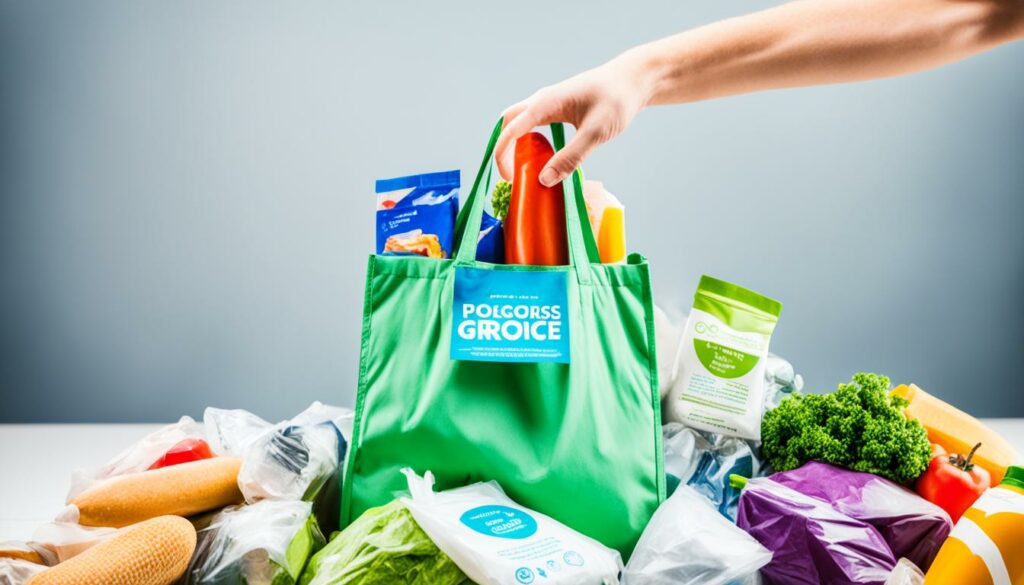Are you ready to take a small step that can make a big impact on the environment? It’s time to embrace an eco-friendly lifestyle. By making simple, sustainable changes in your everyday life, you can contribute to a greener future and create a more sustainable world for future generations. But where do you start? How can you incorporate eco-friendly practices into your daily routine?
This article will explore tips and ideas for eco-friendly living, from reducing energy consumption to choosing environmentally friendly products. Together, let’s discover how small changes in our daily lives can add up to make a significant difference.
Key Takeaways:
- Embracing an eco-friendly lifestyle is a continuous journey that requires commitment and conscious choices.
- Simple tips for eco-friendly living cover different aspects of sustainable living.
- Making eco-friendly home improvements can significantly contribute to a greener lifestyle.
- Being mindful of shopping and consumption habits is essential for eco-friendly living.
- Maintaining personal hygiene and making sustainable travel choices are vital aspects of eco-friendly living.
Simple Tips for Eco-Friendly Living
To kickstart your eco-friendly journey, here are some simple tips that cover different aspects of sustainable living:
1. Reduce Energy Consumption
Lowering your energy usage benefits the environment and saves you money. Some ways to achieve this include:
- Switching off lights and appliances when not in use
- Utilizing natural light during the day
- Opting for energy-efficient light bulbs
2. Practice Waste Reduction
Minimizing waste is essential for a sustainable lifestyle. Consider the following actions:
- Recycling paper, plastic, glass, and other recyclable materials
- Composting food scraps
- Using reusable bags, bottles, and containers
3. Choose Environmentally Friendly Products
Supporting eco-conscious brands and purchasing environmentally friendly products can make a significant difference. Look for:
- Biodegradable and non-toxic cleaning supplies
- Organic and locally sourced food
- Zero-waste and plastic-free alternatives
4. Embrace Sustainable Transportation
Reducing your carbon footprint through sustainable transportation options is crucial. Consider these eco-friendly alternatives:
- Walking or biking for short distances
- Using public transportation or carpooling
- Investing in electric vehicles or hybrids
5. Conserve Water
Preserving water resources is an essential part of an eco-friendly lifestyle. Practice these water-saving tips:
- Fixing leaks promptly
- Taking shorter showers
- Watering plants during cooler hours
6. Support Local and Sustainable Agriculture
Choosing local and sustainably produced food benefits the environment and your health. Consider these actions:
- Shopping at farmers’ markets and buying seasonal produce
- Supporting organic and regenerative farming practices
- Reducing meat and dairy consumption
Remember, transitioning to an eco-friendly lifestyle is an ongoing process. Start implementing these simple tips today, and gradually incorporate more sustainable practices into your daily routine. Together, we can positively impact the environment and create a greener future.
References:
- “Reducing Your Carbon Footprint.” United States Environmental Protection Agency.
- “How to Go Green: 9 Simple Steps to a Greener Lifestyle.” NRDC.
- “Home Energy Saving Tips.” U.S. Department of Energy.
- “Sustainable Living.” World Wildlife Fund.
Eco-Friendly Home Improvements
Making improvements to your home can significantly contribute to a more eco-friendly lifestyle. By implementing sustainable practices and eco-friendly products, you can reduce your carbon footprint and create a greener living space. Here are some ideas to consider:
- Energy-Efficient Lighting: Replace traditional incandescent bulbs with energy-efficient LED or CFL bulbs. These bulbs use less energy and last longer, reducing energy consumption and carbon emissions.
- Renewable Energy: Consider installing solar panels on your roof to harness clean, renewable energy from the sun. This will reduce your reliance on fossil fuels and save you money on electricity bills in the long run.
- Smart Thermostats: Upgrade to a smart thermostat, which optimizes your heating and cooling systems to minimize energy waste. Smart thermostats can learn your preferences, adjust temperatures accordingly, and be controlled remotely through your smartphone.
- Energy-Efficient Appliances: Choose energy-efficient models with the ENERGY STAR label when replacing your appliances. These appliances are designed to consume less energy while maintaining their performance.
- Eco-Cleaning Products: Swap out conventional cleaning products with eco-friendly alternatives. Look for biodegradable, non-toxic products made from natural ingredients to minimize harmful chemicals in your home.
- Biodegradable Household Products: Use biodegradable alternatives for everyday items such as trash bags, paper products, and disposable cutlery. These products are made from renewable materials and break down more easily, reducing their environmental impact.
- Insulation: Properly insulate your home to prevent heat loss during the colder months and reduce the need for excessive heating. Well-insulated homes require less energy to maintain a comfortable temperature.
- Draughtproofing: Seal any gaps or cracks around windows, doors, and other openings to prevent drafts and heat loss. This helps maintain a consistent indoor temperature without relying heavily on heating or cooling systems.
By implementing these eco-friendly home improvements, you can create a more sustainable living environment while reducing energy consumption and carbon footprint.

Sustainable Shopping and Consumption
Being mindful of our shopping and consumption habits is essential for eco-friendly living. By making conscious choices, we can reduce our environmental impact and contribute to a greener future. Here are some sustainable living tips to help you shop and consume more responsibly:
1. Reduce Food Waste
Food waste is a significant issue that contributes to greenhouse gas emissions. To reduce food waste, plan your meals, create shopping lists, and only buy what you need. Store food properly to prolong freshness, and use leftovers creatively to minimize waste.
2. Embrace Recycling
Recycling helps conserve resources and reduces the amount of waste that ends up in landfills or oceans. Separate and recycle your recyclable items, such as plastic, glass, paper, and metal. Familiarize yourself with your local recycling guidelines and dispose of your waste accordingly.
3. Go Plastic-Free
Plastic pollution is a severe threat to our environment and wildlife. Reduce your plastic consumption using reusable alternatives such as stainless steel water bottles, cloth grocery bags, and glass food containers. Say no to single-use plastics like plastic straws, cutlery, and packaging whenever possible.
4. Shop Locally
Support local businesses and reduce your carbon footprint by shopping locally. Buying from local farmers’ markets, food co-ops, and independent stores helps the local economy and reduces the environmental impact associated with transportation and long-distance shipping.
“Shopping locally not only benefits the environment, but it also fosters a sense of community and strengthens local economies.”
5. Try Foraging
Foraging for wild, edible plants is an excellent way to connect with nature and reduce your reliance on store-bought produce. Educate yourself on local foraging regulations and guidelines, and only harvest responsibly and sustainably.
6. Reduce Packaging
Excessive packaging contributes to waste and pollution. Whenever possible, choose products with minimal or eco-friendly packaging. Look for refillable options, bulk bins, or stores that offer unpackaged goods. Bringing your own reusable bags and containers can also help reduce packaging waste.
“Choosing products with minimal packaging not only saves resources but also encourages businesses to adopt more sustainable packaging practices.”
By incorporating these sustainable shopping and consumption practices into our daily lives, we can reduce our environmental footprint and contribute to a healthier planet.

By reducing food waste, recycling, going plastic-free, shopping locally, foraging, and minimizing packaging, we can make a positive impact and pave the way for a more sustainable future.
Sustainable Personal Care and Travel
Taking care of our hygiene and making sustainable travel choices are vital aspects of eco-friendly living. We can reduce our carbon footprint and contribute to a greener planet by adopting eco-conscious practices in these areas. Here are some tips to help you live a more sustainable lifestyle:
Sustainable Personal Care
1. Use green cleaning products: Opt for environmentally friendly cleaning products that are free from harmful chemicals and toxins. Look for eco-friendly certifications, such as the EPA’s Safer Choice label, when choosing cleaning products for your home.
2. Embrace zero-waste personal care: Reduce waste by opting for zero-waste personal care products such as shampoo bars, soap bars, and solid toothpaste. These products often come in minimal or plastic-free packaging, making them a sustainable choice.

3. Choose sustainable beauty brands: Look for beauty and skincare brands that prioritize sustainability and use natural, organic ingredients. Many brands now offer eco-friendly packaging, refillable options, and cruelty-free products.
Sustainable Travel
1. Opt for public transportation: Utilize public transportation options such as buses and trains whenever possible. This helps reduce emissions and lowers your carbon footprint, contributing to a cleaner environment.
2. Walk or bike for short distances: Consider walking or biking for short distances instead of relying on cars or taxis. This not only reduces emissions but also promotes a healthier lifestyle.
3. Pack eco-friendly travel essentials: When traveling, pack eco-friendly essentials such as reusable water bottles, stainless steel straws, and cloth bags. These reusable items help minimize single-use plastic waste.
| Benefits of Sustainable Personal Care and Travel | Examples |
|---|---|
| Reduces environmental impact | Using eco-friendly personal care products and choosing sustainable travel options significantly reduces our carbon footprint and helps to protect the planet. |
| Promotes a healthier lifestyle | By embracing zero-waste personal care and choosing active travel options such as walking or biking, we contribute to our well-being and overall health. |
| Inspires others to follow | Adopting sustainable personal care and travel habits can inspire others to make environmentally conscious choices, creating a ripple effect for positive change. |
By integrating these sustainable practices into our daily lives, we can live harmoniously with the environment and pave the way for a greener future.
Conclusion
Embracing an eco-friendly lifestyle is a continuous journey that requires commitment and conscious choices. By applying sustainable practices in various aspects of our lives, from home improvements to shopping habits, we can make a significant difference in creating a more sustainable world for future generations.
Throughout this article, we have explored various tips and ideas for eco-friendly living. We have learned about reducing energy consumption, choosing environmentally friendly products, making eco-friendly home improvements, mindful shopping and consumption, and sustainable personal care and travel choices.
Each small step towards an eco-friendly lifestyle contributes to a greener future. Whether it’s installing energy-efficient appliances, reducing plastic waste, or opting for zero-waste personal care products, every action counts. Let’s continue to make eco-conscious decisions and inspire others to join us on this journey towards a more sustainable and eco-friendly way of living.






